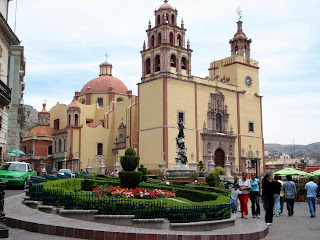

Friday – Week 9: Guanajuato is clearly one of the most fascinating cities you could ever visit, and it is right here on our continent. Our kids were leaving early Saturday morning so they were staying at a hotel near the airport. It was a convenient day to visit Dolores Hidalgo and Guanajuato and then drop them off at the end of the day before our return to San Miguel.
Guanajuato is the state capital of the colonial area and dates from the 1500’s. It is built in a steep canyon and all the buildings go right up the sides of the canyon and are gaily painted in multiple bright colors similar to the Mediterranean. When the Spanish arrived it became one of the three greatest silver cities of the empire. The city of about 100,000 has a very European flavor. It includes the prestigious University of Guanajuato with 8,000 students founded by the Jesuits in the mid 1700’s and is famous for its music and theater.
A unique feature of Guanajuato is that they have converted a river bed and mine shafts under the city into automobile tunnels. They criss-cross all over and have made it so we have never parked in the same area twice (because we are usually lost). What this has accomplished is allowing most of the city to be pedestrian only on the surface. This provides for beautiful squares, parks, vistas and beautiful public buildings and theaters. There are many outside restaurants and it makes it feel very Parisian.
Above the city on one of the mountain sides there is a huge monument of El Papila, one of the hero’s of the battle of the granary in Guanajuato during the Revolution of Independence in 1810. It is accessible by a very steep funicular that starts behind the Teatro Juarez and Union Square. We all took the funicular (even Mary Ann, but I suspect with her eyes closed) and enjoyed the wonderful views of Guanajuato. It was all a very wonderful final day for the family. Geoff was advocating that we should buy a home in San Miguel. Oh sure! A website with several excellent photos is at: http://www.mexconnect.com/MEX/mxc/gto.html.
Quirky (but Important) Living Note: Because of the involvement of a friend, we learned of the role of an organization called the 24 Hour Association. Because of the large population of Americans and Canadians in San Miguel, and as most are retired, there inevitably will be an occasional death. This can be a major problem when in a foreign country, because of the different laws, regulations and requirements. For instance, Mexico requires burial within 24 hours of death. Thus a wonderful association was formed to help the expats with such problems. For a modest joining fee, the association members and staff will immediately take over and handle all of the problems, arrangements, and details when a death occurs. An excellent article about the association was written by Natalie Hardy, who is the sister of Pat Malone in Wenatchee. You can read the article in a recent issue from the archives of Atención newspaper: http://www.atencionsanmiguel.org/index.php?engarchives.
Guanajuato is the state capital of the colonial area and dates from the 1500’s. It is built in a steep canyon and all the buildings go right up the sides of the canyon and are gaily painted in multiple bright colors similar to the Mediterranean. When the Spanish arrived it became one of the three greatest silver cities of the empire. The city of about 100,000 has a very European flavor. It includes the prestigious University of Guanajuato with 8,000 students founded by the Jesuits in the mid 1700’s and is famous for its music and theater.
A unique feature of Guanajuato is that they have converted a river bed and mine shafts under the city into automobile tunnels. They criss-cross all over and have made it so we have never parked in the same area twice (because we are usually lost). What this has accomplished is allowing most of the city to be pedestrian only on the surface. This provides for beautiful squares, parks, vistas and beautiful public buildings and theaters. There are many outside restaurants and it makes it feel very Parisian.
Above the city on one of the mountain sides there is a huge monument of El Papila, one of the hero’s of the battle of the granary in Guanajuato during the Revolution of Independence in 1810. It is accessible by a very steep funicular that starts behind the Teatro Juarez and Union Square. We all took the funicular (even Mary Ann, but I suspect with her eyes closed) and enjoyed the wonderful views of Guanajuato. It was all a very wonderful final day for the family. Geoff was advocating that we should buy a home in San Miguel. Oh sure! A website with several excellent photos is at: http://www.mexconnect.com/MEX/mxc/gto.html.
Quirky (but Important) Living Note: Because of the involvement of a friend, we learned of the role of an organization called the 24 Hour Association. Because of the large population of Americans and Canadians in San Miguel, and as most are retired, there inevitably will be an occasional death. This can be a major problem when in a foreign country, because of the different laws, regulations and requirements. For instance, Mexico requires burial within 24 hours of death. Thus a wonderful association was formed to help the expats with such problems. For a modest joining fee, the association members and staff will immediately take over and handle all of the problems, arrangements, and details when a death occurs. An excellent article about the association was written by Natalie Hardy, who is the sister of Pat Malone in Wenatchee. You can read the article in a recent issue from the archives of Atención newspaper: http://www.atencionsanmiguel.org/index.php?engarchives.

No comments:
Post a Comment